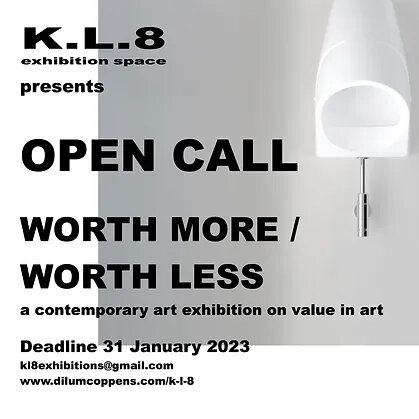Open Call
Worth More / Worth Less

For an upcoming group exhibition, K.L.8 is looking for visual artists whose work reflects on the fact of 'value' in art. In what sense can you say a work of art has value? And should this be limited to material and monetary value, or can art have other types of value, such as social value, spiritual value, emotional value, ...?
K.L.8 is an exhibition space founded in 2019 by Sandra Meilūnaitė & Dilum Coppens, and joined in 2022 by Yannick Marien. After opening up their studio and adjoining space for an exhibition under the name "BETWEEN (STAGE)", they decided to keep the ball rolling, renovate the room and use it as an artist-run exhibition space for young and emerging artists. By hosting regular exhibitions for artists trying to do what they love, they hope to show Brussels the fresh young faces of promising creators, and broaden both the artists’ as their own network.
For the exhibition Worth More/Worth Less, K.L.8 is looking for works by artists who deal with the complex and elusive notion of value, and who bring an unexpected point of view to an often-repeated question : 'What is it all worth in the end?'
To participate you can fill out our form via following link: https://forms.gle/dZB69kZVEc7Fm94P6
Alongside general information, we ask for a proposal of max. 5 works or 2 series, a portfolio, an artist statement of max. 1 A4 and an artistic cv of max. 1 A4. All documents are to be submitted in PDF-format.
For any further questions, you can reach us at kl8exhibitions@gmail.com.
For over a century, the boundaries of this concept have been investigated by a diverse array of artists. Duchamp started out by using an industrially manufactured object for his Fountain instead of creating a traditional, unique art object. Conceptual artists Sol LeWitt and Lawrence Weiner sold written instructions to gallerists and institutions, and considered the physical execution of these instructions to be of secondary importance. With Merda d’Artista, Manzoni sold his own tinned excrement at the gold price, while recently Maurizio Cattelan had a golden toilet plumbed into Blenheim palace and managed to generate an inordinate amount of attention for a banana he duct-taped to the wall at an art fair.
Historically, there have always been gatekeepers with the power to determine the value of an artwork—from the wealthy patrons in ancient Greece and Rome, the Catholic Church, over Renaissance aristocracy, to feudal rulers and emperors. Today might not be that different: those with capital exercise considerable influence in the contemporary art world, and established commercial galleries and well-funded museums govern the market.
Despite such confinements, modern and contemporary artists have widely experimented with value in their works, challenging the conditions that can decide the nature of value, still eliciting discussion and outrage. We are curious what the new generation of artists has to add to the conversation. Surely they are met with the same problem as ever: the possibility that their work is ignored or deemed worthless by the current gatekeepers. In our modern economy, raw materials are usually transformed, through labour and engineering, into products that are more valuable than the sum of their components, yet many artists buy their art supplies and transform them into something that loses almost all of its original economic value.
Ontwerp: Studio Mast | Website: eps en kaas
